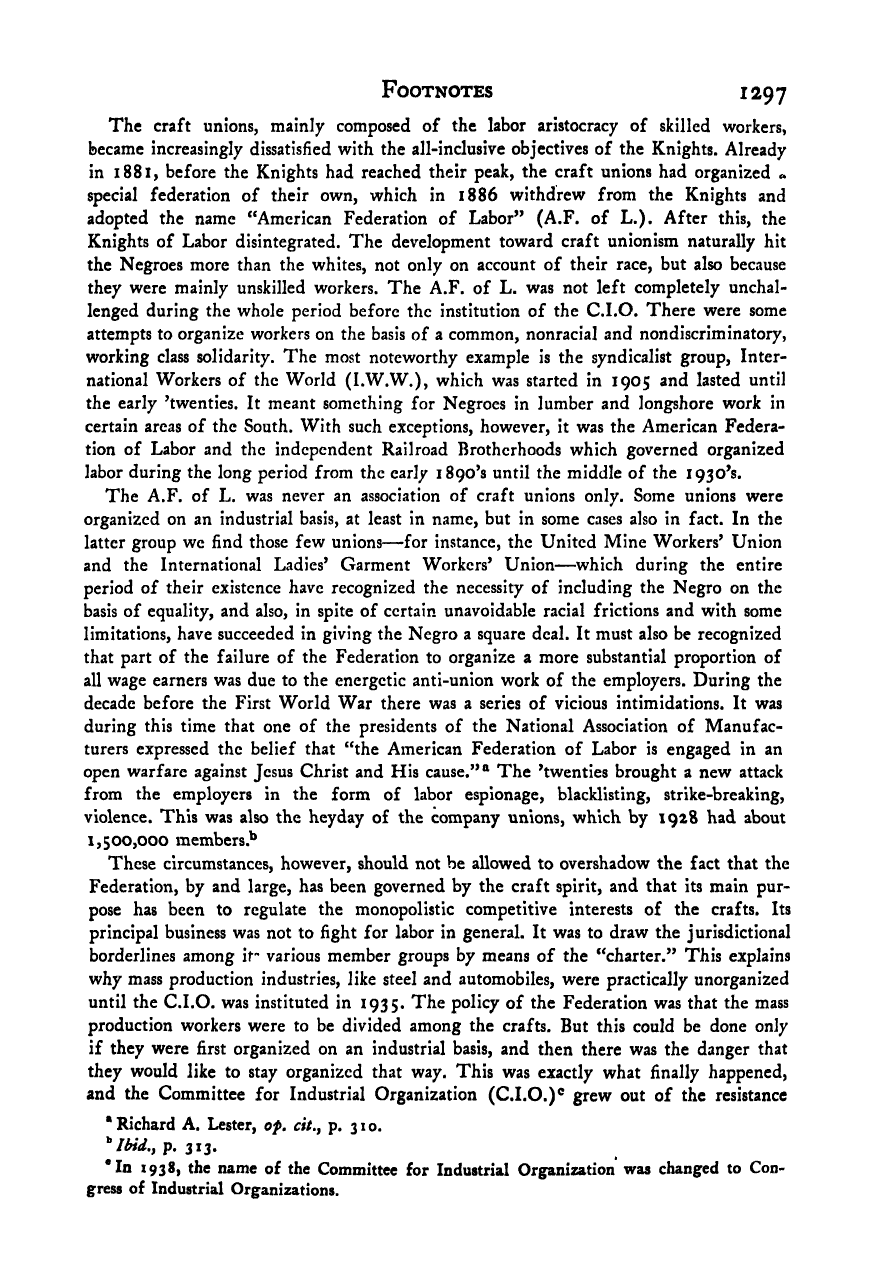Note: Gunnar Myrdal died in 1987, less than 70 years ago. Therefore, this work is protected by copyright, restricting your legal rights to reproduce it. However, you are welcome to view it on screen, as you do now. Read more about copyright.
Full resolution (TIFF) - On this page / på denna sida - Footnotes - Chapter 18

<< prev. page << föreg. sida << >> nästa sida >> next page >>
Below is the raw OCR text
from the above scanned image.
Do you see an error? Proofread the page now!
Här nedan syns maskintolkade texten från faksimilbilden ovan.
Ser du något fel? Korrekturläs sidan nu!
This page has never been proofread. / Denna sida har aldrig korrekturlästs.
Footnotes 1297
The craft unions, mainly composed of the labor aristocracy of skilled workers,
became increasingly dissatisfied with the all-inclusive objectives of the Knights. Already
in 1881, before the Knights had reached their peak, the craft unions had organized **
special federation of their own, which in 1886 withdrew from the Knights and
adopted the name “American Federation of Labor” (A.F. of L.). After this, the
Knights of Labor disintegrated. The development toward craft unionism naturally hit
the Negroes more than the whites, not only on account of their race, but also because
they were mainly unskilled workers. The A.F. of L. was not left completely unchal-
lenged during the whole period before the institution of the C.I.O. There were some
attempts to organize workers on the basis of a common, nonracial and nondiscrim inatory,
working class solidarity. The most noteworthy example is the syndicalist group, Inter-
national Workers of the World (I.W.W.), which was started in 1905 and lasted until
the early ’twenties. It meant something for Negroes in lumber and longshore work in
certain areas of the South. With such exceptions, however, it was the American Federa-
tion of Labor and the independent Railroad Brotherhoods which governed organized
labor during the long period from the early 1890’s until the middle of the 1930’s.
The A.F. of L. was never an association of craft unions only. Some unions were
organized on an industrial basis, at least in name, but in some cases also in fact. In the
latter group we find those few unions—for instance, the United Mine Workers’ Union
and the International Ladies’ Garment Workers’ Union—which during the entire
period of their existence have recognized the necessity of including the Negro on the
basis of equality, and also, in spite of certain unavoidable racial frictions and with some
limitations, have succeeded in giving the Negro a square deal. It must also be recognized
that part of the failure of the Federation to organize a more substantial proportion of
all wage earners was due to the energetic anti-union work of the employers. During the
decade before the First World War there was a series of vicious intimidations. It was
during this time that one of the presidents of the National Association of Manufac-
turers expressed the belief that “the American Federation of Labor is engaged in an
open warfare against Jesus Christ and His cause.” The ’twenties brought a new attack
from the employers in the form of labor espionage, blacklisting, strike-breaking,
violence. This was also the heyday of the company unions, which by 1928 had about
1,500,000 members.^
These circumstances, however, should not be allowed to overshadow the fact that the
Federation, by and large, has been governed by the craft spirit, and that its main pur-
pose has been to regulate the monopolistic competitive interests of the crafts. Its
principal business was not to fight for labor in general. It was to draw the jurisdictional
borderlines among if" various member groups by means of the “charter.” This explains
why mass production industries, like steel and automobiles, were practically unorganized
until the C.I.O. was instituted in 1935. The policy of the Federation was that the mass
production workers were to be divided among the crafts. But this could be done only
if they were first organized on an industrial basis, and then there was the danger that
they would like to stay organized that way. This was exactly what finally happened,
and the Committee for Industrial Organization (C.I.O.)® grew out of the resistance
* Richard A. Lester, op. cit.^ p. 310.
Ibid.f p. 313.
* In 1938, the name of the Committee for Industrial Organization was changed to Con-
gress of Industrial Organizations.
<< prev. page << föreg. sida << >> nästa sida >> next page >>